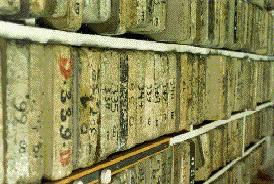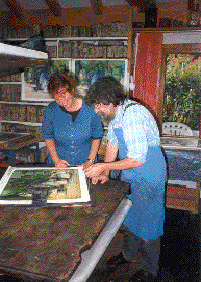Litho - and
lithography
Toos van Holstein
working on
a lithograph
|
Litho - and
|
Litho is short for lithography. This is a word combination of the Greek words lithos (= stone) and graphein (= writing). A litho therefore is an impression or text drawn on to or written on a stone.
 The process of lithography was found by Aloys Senefelder in the early years of the nineteenth century. In those day this meant a major improvement in the process of constructing maps and musical prints. During the following years artists were to discover the potentiality of lithography as well. The Frenchman Daumier used it to produce his well-known drawings. Toulouse Lautrec was to become the pioneer of coloured lithographies. It is hardly possible to find any person without any notion of his pictures of Paris' fin-de-siècle night life. The picture at left shows a lithographer's depot.
The process of lithography was found by Aloys Senefelder in the early years of the nineteenth century. In those day this meant a major improvement in the process of constructing maps and musical prints. During the following years artists were to discover the potentiality of lithography as well. The Frenchman Daumier used it to produce his well-known drawings. Toulouse Lautrec was to become the pioneer of coloured lithographies. It is hardly possible to find any person without any notion of his pictures of Paris' fin-de-siècle night life. The picture at left shows a lithographer's depot.
In the nineteenth century they also discovered photography. Particularly in our twentieth century the process laid the path for different sorts of printing, eventually detaching lithography from its original meaning. Printers still use the word 'litho' for a technique which has no connection to anything resembling a stone. The term 'litho' is often abused when selling photographically produced artistic printings. On some occasions these are merely luxurious posters representing existing paintings. Of course there is a luxurious price involved as well.
Whenever you run into art magazine adverts concerning crystal lithos one should realise these are only gentrified posters. It is an enlarged copy of an existing painting with diminished photographic screen marks thanks to the application of modern printing techniques.
Besides this an obscure reputation is slowly gaining ground through regular press publications about emerging falsifications. It has happened that 'lithos' were offered for sale - being only copies of original lithos with the artist's signature photographed along!
All this resulted into the current usage in English speaking countries of 'stone lithograph' - in fact referring to 'stone' twice. Anyway: when we speak about a lithograph what we really mean is: a solid, handmade piece of art, issued in a limited number of copies each numbered and signed by the artist.
The process
Making a lithography is an arduous and technically quite a complicated job. The first stage is grinding and polishing the stone. It is clear that a certain limy stone, quarried in Southern Germany, works best. Some stones have a rich past, being in use for over a hundred years. Each time an issue has been completed the surface of the stone gets scoured and polished, removing the image forever. After polishing the stone the image gets mounted on the stone in black and shades of grey. Here lithographic tools are used: special crayons, pencils or tusche - a special kind of ink. The image may be brought upon the stone in one sequence. The specific lithographic materials put a greasy layer on the marked places of the stone. Here we see the principle of lithography at work. Drops of water are known to place themselves in neat small circles on a greasy plate where they flow out in random patterns on a clean one! This is caused by the mutual repulsion of grease and water.
All individual sheets demand a series of separate printings, each adding new characteristics and colours to the image. In this way the lithography emerges step-by-step. The paper produces a mirror-wise impression of the original image. The artist has to consider this beforehand. He will check the results of his drawing on the stone by looking into a mirror. The printer Making a lithography is an art in itself. Collaboration between lithographer and printer goes without saying. Like in a chess game artist and printer must think ahead many moves. This applies to the chemical magic in edging the stone, the shades of colours when printing, but most of all they should foresee what may happen during the next series of printing. Making a litho is still an act of old fashioned craftsmanship. In the course of time lithography has lost some of its impact. However, in Europe we still find very able printers. Van Holstein worked in the notable studio of Piet Clement in Amsterdam. She also worked with Ernst Hanke who owns a renowned lithographer's workshop in Switzerland. Artists of various nationalities enjoy working there. A lithograph is made in a previously established number of copies ranging from a few dozen up till several hundreds. On the picture left Toos van Holstein en Ernst Hanke critically observe the final result of the printing Toos' lithograph Feria. De two of them produced this lithograph after eleven different printings in an issue of 125. After the final printing the stone must be scoured and polished, made ready for a next user. Each copy is a separate piece of art since each sheet demands to be inked, colour after colour, printing after printing. Each picture will have its own number: 12 / 100 means that this must be copy number 12 in a series of 100. Each copy has been marked - and signed - by the artist.  The stone is sponged, causing the parts without any image to become moist. A chosen colour of printing ink is now applied on the stone, the ink will remain only on those parts containing an image. Then a sheet of especially dipped paper is laid on the inked stone and the press sees to it that the paper gets its first colour. On the picture right the impression of Amparo on the stone is seen in black en grey shades. (Click here to see the final result of Amparo).
The stone is sponged, causing the parts without any image to become moist. A chosen colour of printing ink is now applied on the stone, the ink will remain only on those parts containing an image. Then a sheet of especially dipped paper is laid on the inked stone and the press sees to it that the paper gets its first colour. On the picture right the impression of Amparo on the stone is seen in black en grey shades. (Click here to see the final result of Amparo).
